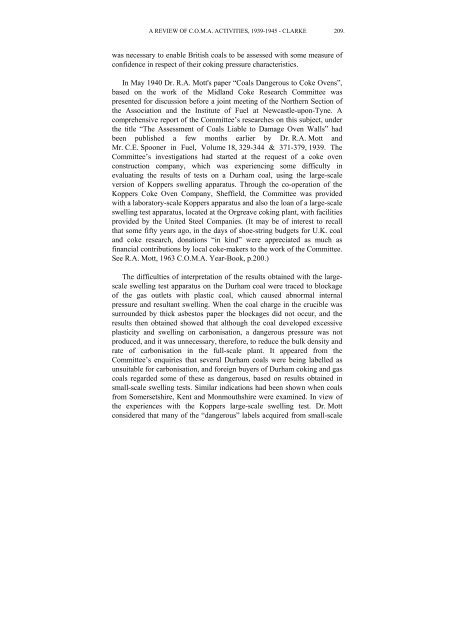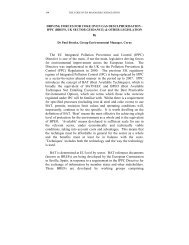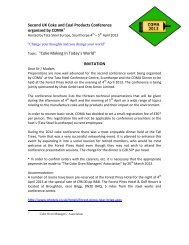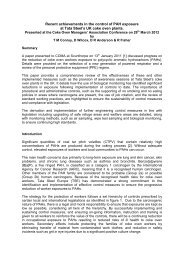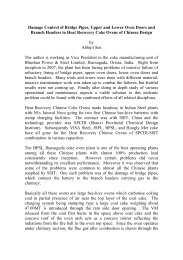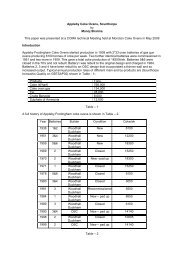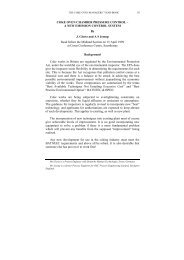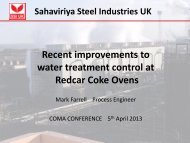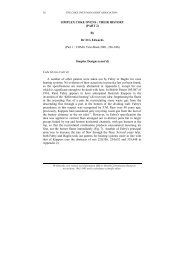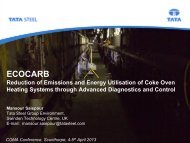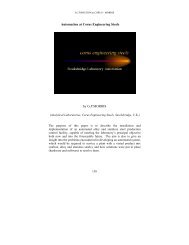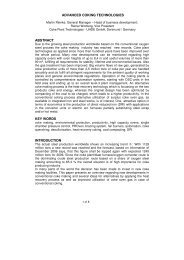CHAIRMAN'S ADDRESS - Coke Oven Managers Association
CHAIRMAN'S ADDRESS - Coke Oven Managers Association
CHAIRMAN'S ADDRESS - Coke Oven Managers Association
- No tags were found...
You also want an ePaper? Increase the reach of your titles
YUMPU automatically turns print PDFs into web optimized ePapers that Google loves.
A REVIEW OF C.O.M.A. ACTIVITIES, 1939-1945 - CLARKE 209.was necessary to enable British coals to be assessed with some measure ofconfidence in respect of their coking pressure characteristics.In May 1940 Dr. R.A. Mott's paper “Coals Dangerous to <strong>Coke</strong> <strong>Oven</strong>s”,based on the work of the Midland <strong>Coke</strong> Research Committee waspresented for discussion before a joint meeting of the Northern Section ofthe <strong>Association</strong> and the Institute of Fuel at Newcastle-upon-Tyne. Acomprehensive report of the Committee’s researches on this subject, underthe title “The Assessment of Coals Liable to Damage <strong>Oven</strong> Walls” hadbeen published a few months earlier by Dr. R.A. Mott andMr. C.E. Spooner in Fuel, Volume 18, 329-344 & 371-379, 1939. TheCommittee’s investigations had started at the request of a coke ovenconstruction company, which was experiencing some difficulty inevaluating the results of tests on a Durham coal, using the large-scaleversion of Koppers swelling apparatus. Through the co-operation of theKoppers <strong>Coke</strong> <strong>Oven</strong> Company, Sheffield, the Committee was providedwith a laboratory-scale Koppers apparatus and also the loan of a large-scaleswelling test apparatus, located at the Orgreave coking plant, with facilitiesprovided by the United Steel Companies. (It may be of interest to recallthat some fifty years ago, in the days of shoe-string budgets for U.K. coaland coke research, donations “in kind” were appreciated as much asfinancial contributions by local coke-makers to the work of the Committee.See R.A. Mott, 1963 C.O.M.A. Year-Book, p.200.)The difficulties of interpretation of the results obtained with the largescaleswelling test apparatus on the Durham coal were traced to blockageof the gas outlets with plastic coal, which caused abnormal internalpressure and resultant swelling. When the coal charge in the crucible wassurrounded by thick asbestos paper the blockages did not occur, and theresults then obtained showed that although the coal developed excessiveplasticity and swelling on carbonisation, a dangerous pressure was notproduced, and it was unnecessary, therefore, to reduce the bulk density andrate of carbonisation in the full-scale plant. It appeared from theCommittee’s enquiries that several Durham coals were being labelled asunsuitable for carbonisation, and foreign buyers of Durham coking and gascoals regarded some of these as dangerous, based on results obtained insmall-scale swelling tests. Similar indications had been shown when coalsfrom Somersetshire, Kent and Monmouthshire were examined. In view ofthe experiences with the Koppers large-scale swelling test. Dr. Mottconsidered that many of the “dangerous” labels acquired from small-scale


